LATEST STORIES
Color Theory and the Importance of Its Role in Visual Communications

Colors are an important part of our life, and they communicate different emotions and sentiments. Subconsciously, a lot of us are following the concepts of color theory. In this blog post, we will shed some light on color theory and its importance in visual communication.
What Is Color Theory?
Color theory can be defined as,
“The collection of rules and guidelines which designers use to communicate with users through appealing color schemes in visual interfaces.”
Color theory has an important role in branding, and it can communicate your ideas to an audience without using any words. It’s the most subtle way of communication and most creative as well.
To pick relevant colors that communicate brand identity, designers must learn how to use the color wheel. The color wheel is a family of colors with various options that help designers stay in the same family of colors yet creative by manipulating hue and saturation.
What Is the Role of Color Theory in Visual Communication?
Colors are basically wavelengths of light. However, Isaac Newton took a new approach to this idea and created visual communication through colors. When defined systematically, there are three categories of colors.
- Primary (red, green, and blue)
- Secondary (mixes of primary colors)
- Tertiary (or intermediate – mixes of primary and secondary colors)
These three types of colors are basic means of communication. However, when it comes to branding, colors play a different role.
Red
Red is mainly used for food brands. This color amplifies hunger, and you can find famous food chains using this color with a mixture of others, such as KFC, McDonald’s, Arby’s, Burger King, and Hardee’s. These are all top brands that communicate their business offering through visualization.
Blue
Blue is a dominant color, and it is mostly used without any other color. This color signifies trust and companionship. That’s why you will find most businesses with blue brand designs who want to gain their customer’s trust. For example, Ford, Facebook, Oreo, HP, American Express, PayPal, Skype, and VISA.
Green
Green is a strong color, and it’s hard to find a contrast with it. Green signifies harmony and balance. Therefore, most nature brands and organizations based on harmony and balance use green color in their brand designs. Brands that use green in their communications include Starbucks, Tropicana, Animal Planet, and Land Rover.
In Summary
Colors are important for conveying your brand message. Most food ads incorporate red in their brand designs to amplify hunger. Similarly, you will find a touch of green in brands that advocate nature and blue in the ones that want to cultivate trust. A mixture of these colors has more or less the same meaning. These responses are naturally created in our brains, and marketers are utilizing this opportunity. If you want your brand to represent your business offering, reach out to Creative Business Branding for top-notch marketing strategies, business agility, and brand designs.
Read Next
 15 November 2024 by Fahmida Islam, in Uncategorized
15 November 2024 by Fahmida Islam, in UncategorizedMastering CRM: A Guide to Cultivating Lasting Customer Relationships
In today’s fast-paced business world, staying connected with your customers is m...READ MORE + 12 October 2024 by Fahmida Islam, in Branding,Creative,Graphic Design,Seo,Social Media Marketing,Website,WordPress
12 October 2024 by Fahmida Islam, in Branding,Creative,Graphic Design,Seo,Social Media Marketing,Website,WordPressData-Driven Decisions: Mastering Analytics for Business Success
Data is the key to making smarter, more informed business decisions in todayR...READ MORE + 03 October 2024 by CBB, in Branding,Graphic Design,Marketing,Social Media,Social Media Marketing
03 October 2024 by CBB, in Branding,Graphic Design,Marketing,Social Media,Social Media MarketingUnlocking the Potential of Your Small Business Website: A Comprehensive Guide
Small business owners often juggle numerous roles—from managing daily operations...READ MORE +
